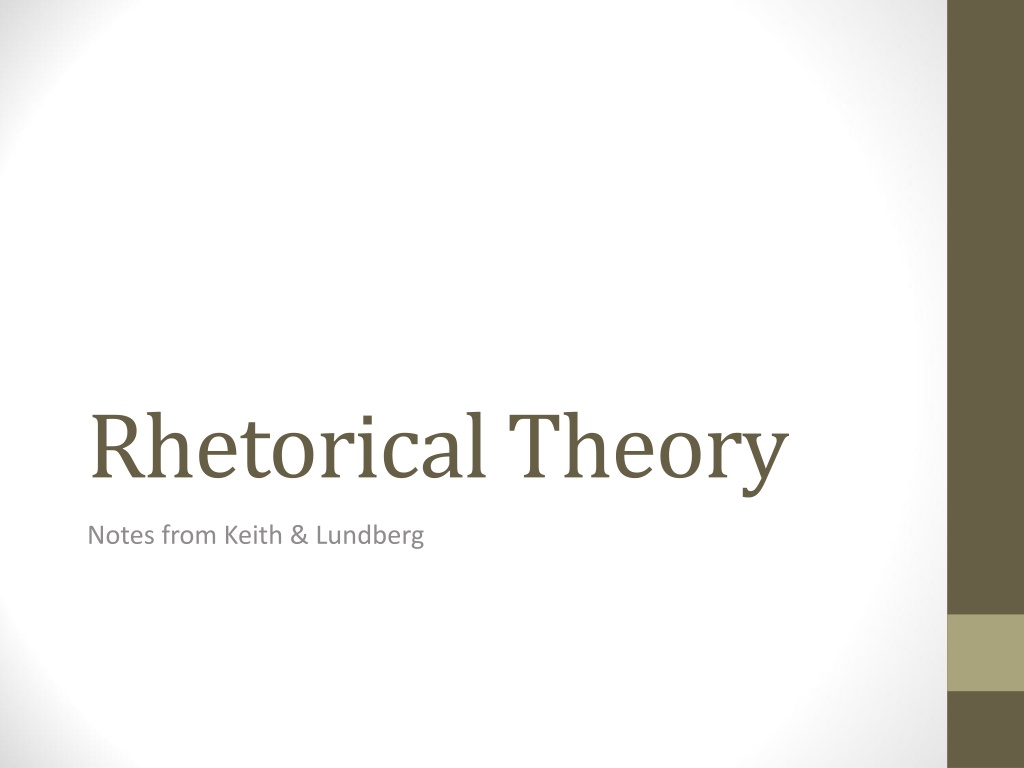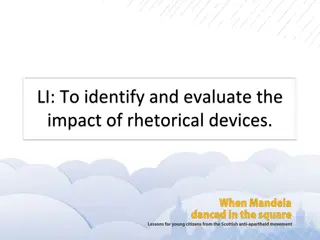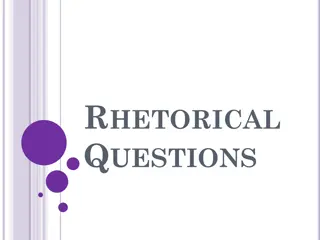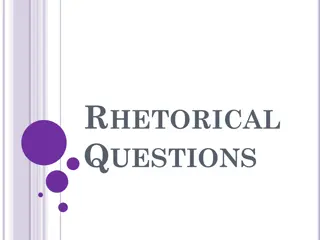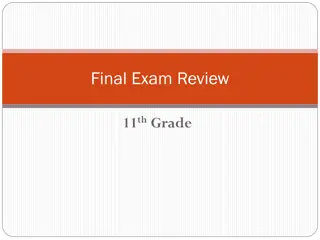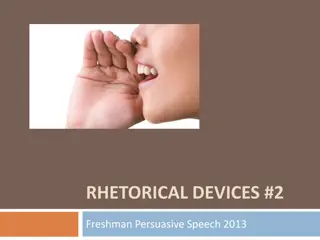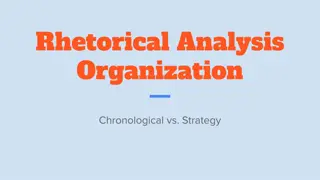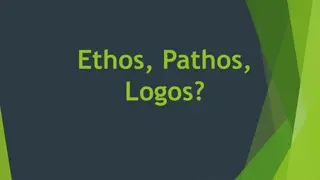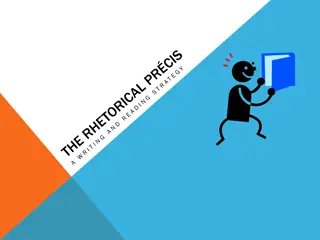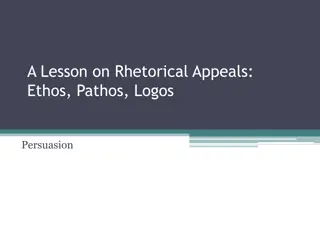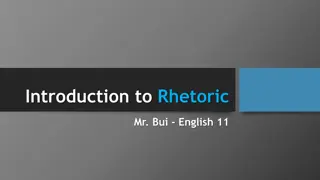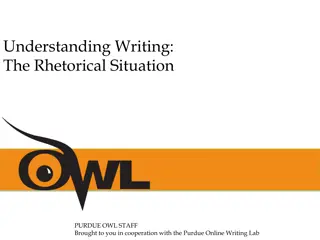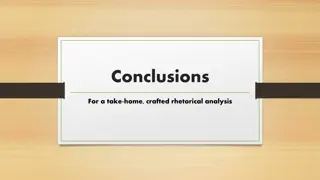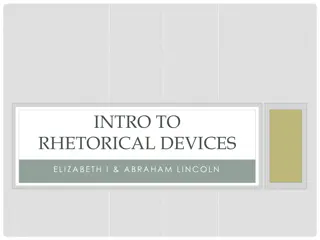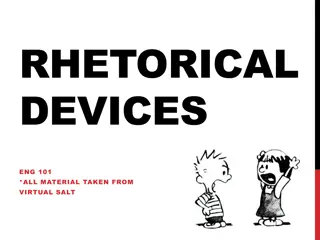Understanding Rhetorical Theory: Key Concepts and Applications
Rhetorical theory explores the study of persuasive language and communication, tracing its origins from Plato to modern applications in shaping identity, power dynamics, and democracy. The theory delves into the importance of audience analysis, ethical considerations, and the interplay between message, sender, receiver, feedback, and medium in effective communication.
Download Presentation

Please find below an Image/Link to download the presentation.
The content on the website is provided AS IS for your information and personal use only. It may not be sold, licensed, or shared on other websites without obtaining consent from the author. Download presentation by click this link. If you encounter any issues during the download, it is possible that the publisher has removed the file from their server.
E N D
Presentation Transcript
Rhetorical Theory Notes from Keith & Lundberg
What is rhetoric? Variety of meanings Persuasive language (any discourse: need not be speech) Books that study such language A style of speaking Overly pretentious language ("mere rhetoric") Any form of communication Also we know a "rhetorical question" as one that needs no answer For us, it's mainly the first definition. Rhetoric is study of how, when and why a discourse is persuasive, causes people to act. [For some, to persuade = get you to do something Convince = get you to believe or think something]
History Plato thought rhetoric was dangerous Aristotle thought rhetoric was any technique of speech It has logic, can be studied Logic and persuasion go hand-in-hand Types of speech (rhetoric) depend on the goals Aristotle's 3 types: forensic., e.g. at a trial (examines the past) epideictic, e.g. a eulogy (examines the present, how we should feel) deliberative, e.g. in the senate (examines the future)
Some applications today Identity and power: certain discourses of identity (ways of representing yourself) can be persuasive, while others can be discriminatory Visual and material symbols: discourse can also be visual, symbolic and therefore symbols can have persuasive power Q: What are some key persuasive, rhetorical symbols? Persuasive (rhetorical) speech is key to how using communication can shape democracy
The Audience (chapter 2) Key move in rhetoric versus just transmitting information is to examine the audience (or the public). Who is in it? What situation do they find themselves in? How does timing affect the effectiveness of a message? Said another way, a speaker needs to Say the right thing To the right people In the right situation At the right time With the right ethical conditions Communication theory models the basic process thus:
Communication model Message Sender Receiver Feedback Channel or Medium
Computers can communicatesend a signal to a receiver, and there can be feedback, but rhetoric requires understanding of the audience and how it is persuaded. That takes (rhetorical) skill. Aristotle recognized that audiences are not "helpless dupes" and there is no universal formula for persuasion [20-th century studies e.g. by Adorno of propaganda failed to find a 'magic bullet" or hypodermic needle"; Q: What probably inspired these studies?]
Audiences are made, not found This is a key stance for rhetoricians. Obviously an audience brings characteristics to the discourse situation, but speaker can compose or evoke certain feelings and reactions Part of that comes from the speaker's image or persona; rhetoric calls it the speaker's ethos (more to come); think of it like their reputation, which might include that they seem to be ethical and trustworthy The other part comes from how the speaker addresses the audience; how does she ask the audience to see themselves [e.g. as parents vs. taxpayers at a PTA meeting]
Publics As rhetorical situations or forms of address get more public (mediated) speakers need to know if there are certain commonalities among that public audience usually there are; that might be a national identity, a fan group for music or movies 1. There is a public sphere [Jurgen Habermas] where ideas are exchanged and debated; this can include media 2. Rhetoric can have indirect effects because discourse in the public sphere, if framed publically, includes possible effects on others 3. It can be hard to know which messages address us are they meant to be public or private? How, why, when, for whom is a text/discourse persuasive?
Need to adapt to audiences Audiences change Audiences are different to begin with Some are fragmented, some less so Therefore, you need to adapt your premises, reasons, examples and speech, including word choices, to each audience. Audiences vary by Situation and motives, expectations, needs Context and setting Demographics Ideology/psychographics Genre or type of speech/discourse
A balancing act Creating effective rhetorical discourse is a tension between finding common elements and appealing to all as one, versus acknowledging audience segments and finding arguments that suit each group [Q: What are the pros and cons of each approach? ] This also applies to appropriate tone, delivery, choice of words, structure of language (linguistic choices); For example how can gendered pronouns cause negative reactions because of what an audience infers? [Q What are those? How do Keith & Lundberg deal with this issue?]
Ethical choices in language use Don't deceive. That can be either lying by commission (you know it's a lie); lying by omission (you leave out some part, e.g. saying 100,000 jobs were created to persuade people that job market is improving [Q: What's left out here?]); lying by BS [the book spells this out] (you don't know if it's true or not but you say it anyway) Don't leave out possible contrary evidence; arguments must be two-sided Be fair and truthful you owe it to any audience You are accountable for your speech act/discourse and the audience it creates; means (e.g. manipulating an audience) don't justify ends to a true rhetorician
Chapter 3 Rhetorical situations The rhetorical situation is a result of The context The time The audience The circumstances For Aristotle that led to the three types we saw earlier based on their purpose: Forensic (examine the past); epideictic (in the present); deliberative (in the future) For Cicero that was whether the speech was intended to inform, persuade or entertain [also media theory; as well as surveillance of your environment] [Recall that effects also can be classified as cognitive, affective or behavioral]
Sum (?) Who is "speaking" What is being said Who the audience is What the context is Why the discourse is occurring What goals and interests does the speaker have? What goals and interest does the audience have?
